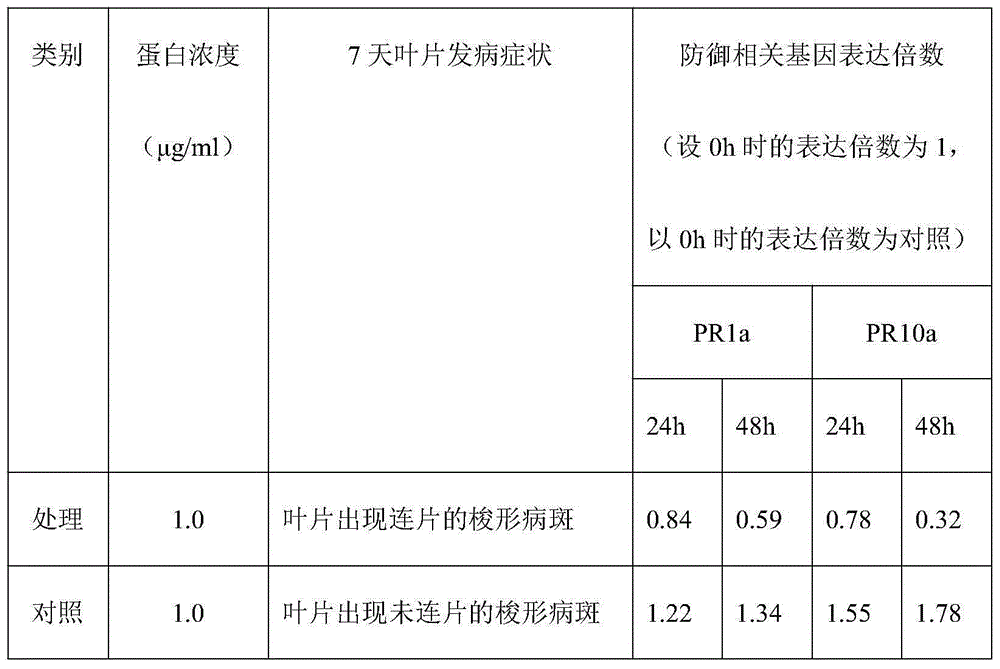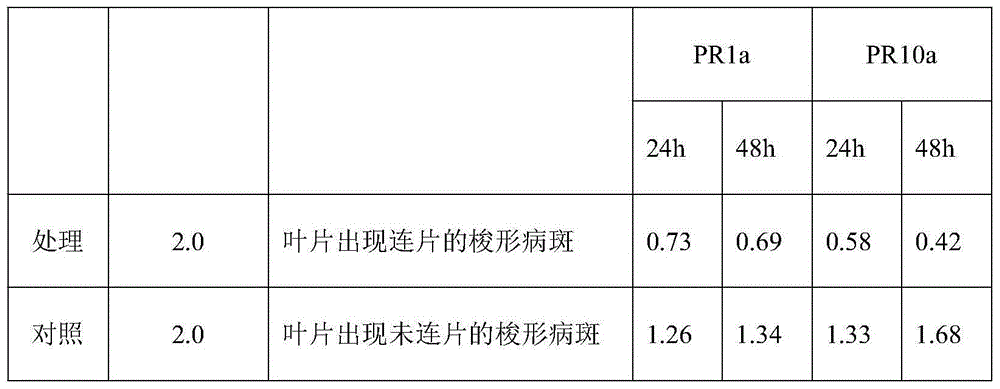Method for detecting magnaporthe grisea genes for enhancing magnaporthe grisea strain pathogenicity
A pathogenicity and gene technology, which is applied in the field of detecting the prokaryotic expression of rice blast genes in vitro and in-strain overexpression to improve the infectivity of the strain, can solve the problems of detecting the effector protein gene of pathogenic bacteria and treating plants with the prokaryotic expression product of a single gene, etc. To achieve the effect of increasing the infectivity of pathogenic bacteria
- Summary
- Abstract
- Description
- Claims
- Application Information
AI Technical Summary
Problems solved by technology
Method used
Image
Examples
Embodiment 1
[0014] The prokaryotic expression product of the gene was centrifuged at 4°C to collect the bacteria, and the bacteria were suspended with freshly prepared buffer solution (20mM Tris-HCl, pH7.4; 200mM NaCl; 1mM EDTA; 10mM β-mercaptoethanol). The supernatant was collected by centrifugation after ultrasonography to disrupt the cells in an ice-water bath. The treatment is ① spray inoculate the prokaryotic expression product of the gene on the leaves of rice variety Lijiang Xintuan Heigu at a concentration of 1.0 μg / ml for 24 hours, then inoculate strong / weak pathogenic strains, and investigate the anti-sensitivity response, real-timeRT- The expression of rice defense-related genes was analyzed by PCR; ②The overexpressed strain of the gene was used to inoculate the leaves of rice variety Lijiang Xintuan Heigu, and the lesion area was measured for 7 days, and the relative growth of fungi on the lesion was analyzed by qPCR. The control is ① Inoculate the prokaryotic expression produ...
Embodiment 2
[0021] The prokaryotic expression product of the gene was centrifuged at 4°C to collect the bacteria, and the bacteria were suspended with freshly prepared buffer solution (20mM Tris-HCl, pH7.4; 200mM NaCl; 1mM EDTA; 10mM β-mercaptoethanol). The supernatant was collected by centrifugation after ultrasonography to disrupt the cells in an ice-water bath. The treatment is ① spray inoculate the prokaryotic expression product of the gene on the leaves of rice variety Lijiang Xintuan Heigu at a concentration of 1.0 μg / ml for 24 hours, then inoculate strong / weak pathogenic strains, and investigate the anti-sensitivity response, real-timeRT- The expression of rice defense-related genes was analyzed by PCR; ②The overexpressed strain of the gene was used to inoculate the leaves of rice variety Lijiang Xintuan Heigu, and the lesion area was measured for 7 days, and the relative growth of fungi on the lesion was analyzed by qPCR. The control is ① Inoculate the prokaryotic expression produ...
Embodiment 3
[0028] The prokaryotic expression product of the gene was centrifuged at 4°C to collect the bacteria, and the bacteria were suspended with freshly prepared buffer solution (20mM Tris-HCl, pH7.4; 200mM NaCl; 1mM EDTA; 10mM β-mercaptoethanol). The supernatant was collected by centrifugation after ultrasonography to disrupt the cells in an ice-water bath. The treatment is ① spray inoculate the prokaryotic expression product of the gene on the leaves of rice variety Lijiang Xintuan Heigu at a concentration of 1.0 μg / ml for 24 hours, then inoculate strong / weak pathogenic strains, and investigate the anti-sensitivity response, real-timeRT- The expression of rice defense-related genes was analyzed by PCR; ②The overexpressed strain of the gene was used to inoculate the leaves of rice variety Lijiang Xintuan Heigu, and the lesion area was measured for 7 days, and the relative growth of fungi on the lesion was analyzed by qPCR. The control is ① Inoculate the prokaryotic expression produ...
PUM
 Login to View More
Login to View More Abstract
Description
Claims
Application Information
 Login to View More
Login to View More - R&D
- Intellectual Property
- Life Sciences
- Materials
- Tech Scout
- Unparalleled Data Quality
- Higher Quality Content
- 60% Fewer Hallucinations
Browse by: Latest US Patents, China's latest patents, Technical Efficacy Thesaurus, Application Domain, Technology Topic, Popular Technical Reports.
© 2025 PatSnap. All rights reserved.Legal|Privacy policy|Modern Slavery Act Transparency Statement|Sitemap|About US| Contact US: help@patsnap.com



